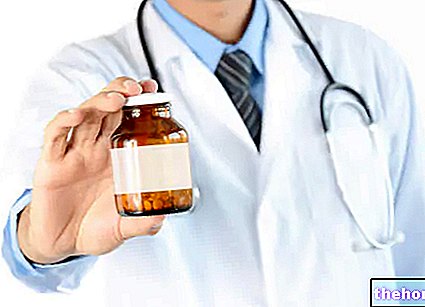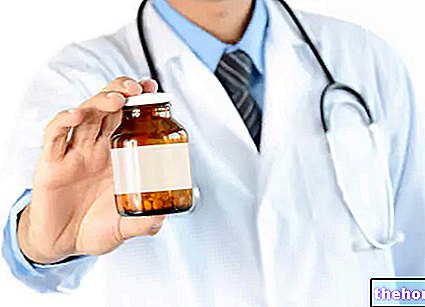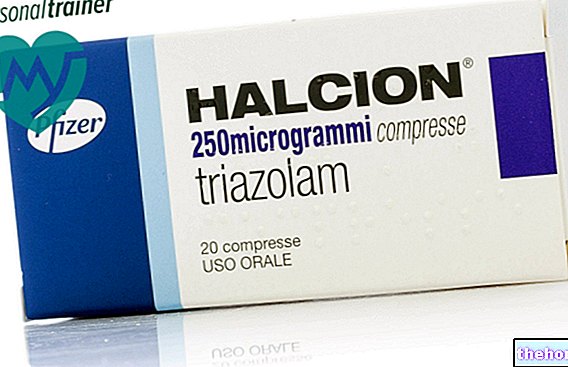Active ingredients: Aciclovir
ACICLOVIR DOC Generici 5% cream
Why is Aciclovir Cream - Generic Drug used? What is it for?
ACICLOVIR DOC Generici is a skin cream that contains the active ingredient aciclovir belonging to a group of medicines used against virus infections (antivirals).
ACICLOVIR DOC Generici is used to treat infections caused by the herpes simplex virus, both in the lips (cold sores) and in the genitals (primary or relapsing genital herpes).
Talk to your doctor if you don't feel better or if you feel worse after a few days.
Contraindications When Aciclovir Cream - Generic Drug should not be used
Do not use ACICLOVIR DOC Generici
- if you are allergic to aciclovir, valaciclovir, propylene glycol or any of the other ingredients of this medicine (listed in section 6).
Precautions for use What you need to know before taking Aciclovir Cream - Generic Drug
Talk to your doctor or pharmacist before using ACICLOVIR DOC Generici.
ACICLOVIR DOC Generici should not be applied to the eyes, nor to the internal mucous membranes of the mouth or vagina, as it may cause irritation.
Talk to your doctor and use this medicine with caution if you have low immune defenses, as you are more sensitive to infections (for example if you have AIDS or if you have had a bone marrow transplant). In this case, aciclovir may need to be given by mouth (oral formulation).
Avoid treatment for long periods, as it can cause an allergic reaction (sensitization). If this happens, stop treatment immediately and contact your doctor.
Interactions Which drugs or foods can modify the effect of Aciclovir Cream - Generic Drug
Tell your doctor or pharmacist if you are using, have recently used or might use any other medicines.
There are no known interactions with other medicines.
Warnings It is important to know that:
Pregnancy and breastfeeding
If you are pregnant or breast-feeding, think you may be pregnant or are planning to have a baby, ask your doctor or pharmacist for advice before using this medicine.
If you are pregnant or breast-feeding, use this medicine only when clearly needed and under the direct supervision of your doctor.
Driving and using machines
There are no data available to establish the effect of the medicine on the ability to drive and use machines.
ACICLOVIR DOC Generici contains propylene glycol
This medicine contains propylene glycol which may cause skin irritation.
Dosage and method of use How to use Aciclovir Cream - Generic Drug: Posology
Always use this medicine exactly as described in this leaflet or as directed by your doctor or pharmacist. If you are unsure, consult your doctor or pharmacist.
The treatment involves 5 applications per day at intervals of about 4 hours.
Apply ACICLOVIR DOC Generici cream to the lesions, or the areas where they are developing, as soon as you notice the first symptoms of the infection (itching, burning sensation or pain).
Continue therapy for at least 5 days and up to a maximum of 10 days.
Overdose What to do if you have taken an overdose of Aciclovir Cream - Generic Drug
If you accidentally take too much ACICLOVIR DOC Generici, contact your doctor immediately or go to the emergency room of the nearest hospital.
Side Effects What are the side effects of Aciclovir Cream - Generic Drug
Like all medicines, this medicine can cause side effects, although not everybody gets them.
The following side effects may occur:
Uncommon: (may affect up to 1 in 100 people)
- transient burning or pain;
- dryness and peeling of the skin;
- itch.
Rare: (may affect up to 1 in 1,000 people)
- redness of the skin (erythema);
- inflammatory skin reaction (contact dermatitis), mainly due to the components of the base cream.
Very rare: (may affect up to 1 in 10,000 people)
- angioedema (swelling of the face, lips, mouth, tongue or throat which may cause difficulty in swallowing and breathing), hives.
Reporting of side effects
If you get any side effects, talk to your doctor or pharmacist. This includes any possible side effects not listed in this leaflet. You can also report side effects directly via the national reporting system at https://www.aifa.gov.it/content/segnalazioni-reazioni-avverse
By reporting side effects, you can help provide more information on the safety of this medicine.
Expiry and Retention
Keep this medicine out of the sight and reach of children.
Do not use this medicine after the expiry date which is stated on the package after "EXP". The expiry date refers to the last day of that month.
Do not store above 25 ° C.
Do not throw any medicines via wastewater or household waste. Ask your pharmacist how to throw away medicines you no longer use. This will help protect the environment.
What ACICLOVIR DOC Generici contains
- The active ingredient is aciclovir. Each gram of cream contains 50 mg of acyclovir.
- The other ingredients are: propylene glycol, tefose, labrafil, vaseline oil, poloxamer 407, sodium lauryl sulfate, purified water.
What ACICLOVIR DOC Generici looks like and contents of the pack
The cream is available in 3g or 10g tube.
Source Package Leaflet: AIFA (Italian Medicines Agency). Content published in January 2016. The information present may not be up-to-date.
To have access to the most up-to-date version, it is advisable to access the AIFA (Italian Medicines Agency) website. Disclaimer and useful information.
01.0 NAME OF THE MEDICINAL PRODUCT
ACICLOVIR DOC GENERICI 5% CREAM
02.0 QUALITATIVE AND QUANTITATIVE COMPOSITION
100 g of cream contains 5 g of aciclovir (equal to 50 mg of aciclovir in 1 g of cream).
Excipient (s) with known effect: propylene glycol.
For the full list of excipients, see section 6.1.
03.0 PHARMACEUTICAL FORM
Cream.
04.0 CLINICAL INFORMATION
04.1 Therapeutic indications
Aciclovir cream is indicated in the treatment of Herpes simplex skin infections such as: primary or recurrent Herpes genitalis and Herpes labialis.
04.2 Posology and method of administration
Aciclovir cream should be applied 5 times a day at approximately 4 hour intervals.
Aciclovir cream should be applied to lesions or areas where they are developing as early as possible after the onset of infection. It is especially important to start treatment of recurrent episodes during the prodrome phase or when lesions first appear. Treatment must continue for at least 5 days and up to a maximum of 10 if there is no healing.
04.3 Contraindications
Hypersensitivity to the active substance, to valaciclovir, to propylene glycol or to any of the excipients listed in section 6.1.
04.4 Special warnings and appropriate precautions for use
The product is not for ophthalmic use. The application of aciclovir cream to mucous membranes such as those of the mouth, eyes or vagina is not recommended because it may cause irritation. Particular care should be taken to avoid accidental application into the eyes.
Animal studies indicate that application of aciclovir cream into the vagina may cause reversible irritation.
The use of the product, especially if prolonged, can give rise to sensitization phenomena, where this happens it is necessary to stop the treatment and consult the attending physician.
In severely immunocompromised patients (e.g. AIDS patients or bone marrow transplant patients) administration of aciclovir in oral formulations should be considered. Such patients should be advised to consult their physician regarding the treatment of any infection.
Important information about some of the ingredients
This medicine contains propylene glycol which may cause skin irritation.
04.5 Interactions with other medicinal products and other forms of interaction
No clinically significant interactions have been identified.
04.6 Pregnancy and lactation
Fertility
Reversible toxic effects on spermatogenesis have been reported in rats and dogs only at systemic dosages significantly higher than therapeutic ones. Two-generation studies in mice revealed no effects of aciclovir, administered orally, on fertility. There are no data on the effects of aciclovir cream on female fertility. Aciclovir tablets have not been shown to affect sperm count, morphology and motility in humans.
See "Clinical studies" in section 5.2.
Pregnancy
The use of aciclovir should only be considered when the potential benefits outweigh any possible unknown risk, even if the systemic exposure to aciclovir following topical application of aciclovir cream is very low.
A registry on the use of aciclovir in pregnancy provided data on pregnancy outcomes in women exposed to different formulations of aciclovir after marketing. The results from the registry did not show an increase in the number of congenital defects among subjects exposed to acyclovir compared to the general population and all congenital defects did not show any particularity or common characteristics that would suggest a single cause.
In conventional, internationally accepted tests, systemic administration of acyclovir did not produce embryotoxic or teratogenic effects in rabbits, rats or mice.
In an unconventional experimental trial, fetal abnormalities were observed in rats but only following subcutaneous doses of aciclovir so high as to produce toxic effects in the mother. The clinical relevance of these findings is uncertain.
Feeding time
Limited data in humans indicate that the drug is found in breast milk after systemic administration. However, the dose received by an infant following the use of aciclovir cream in the mother should be insignificant.
04.7 Effects on ability to drive and use machines
The adverse effects of aciclovir cream on the ability to drive and use machines are not known.
04.8 Undesirable effects
The following convention has been used for the classification of undesirable effects in terms of frequency: very common (≥ 1/10), common (≥ 1/100,
Data from clinical trials were used to assign frequency categories to adverse reactions observed during clinical trials performed with aciclovir 3% ophthalmic ointment.
Due to the nature of the adverse events observed, it is not possible to uniquely determine which events are related to drug administration and which are related to the disease itself. Data from spontaneous reports were used as a basis to determine the frequency of those post-marketing events detected by pharmacovigilance.
Skin and subcutaneous tissue disorders
Uncommon: transient burning or pain after application of aciclovir cream, moderate dryness or peeling of the skin and itching.
Rare: erythema, contact dermatitis after application.
Where susceptibility tests were conducted, it was shown that the reactivity phenomena were related to the components of the cream rather than to acyclovir.
Disorders of the immune system
Very rare: immediate hypersensitivity reactions including angioedema and urticaria.
Reporting of suspected adverse reactions
Reporting of suspected adverse reactions occurring after authorization of the medicinal product is important as it allows continuous monitoring of the benefit / risk balance of the medicinal product. Healthcare professionals are asked to report any suspected adverse reactions via the national reporting system. "address https://www.aifa.gov.it/content/segnalazioni-reazioni-avverse.
04.9 Overdose
Even if the entire contents of a tube containing 500 mg of aciclovir (cream) are ingested, no side effects should be expected, as single doses of 600 mg and daily doses up to 3600 mg have been administered orally. with no side effects reported Single intravenous doses up to 80 mg / kg have been accidentally administered with no side effects Aciclovir is dialysable.
05.0 PHARMACOLOGICAL PROPERTIES
05.1 Pharmacodynamic properties
Aciclovir is a highly active antiviral, in vitro, against Herpes simplex type 1 and 2 and Varicella zoster viruses. Host cell toxicity is low. Once it enters the cell infected with Herpes, aciclovir is transformed into the active compound: aciclovir tri-phosphate. The first stage of the phosphorylation process is dependent on the virus-encoded thymidine kinase. Aciclovir tri-phosphate acts both as a substrate and as an inhibitor of Viral DNA-polymerase blocking the continuation of viral DNA synthesis without interfering with normal cellular processes.
05.2 "Pharmacokinetic properties
Clinical studies
There is no information on the effects of aciclovir oral formulations or solution for infusion on female fertility. In a study of 20 male patients with normal sperm counts, oral administration of aciclovir at doses of up to 1 g per day for up to six months was shown to have no clinically significant effect on number, motility or the morphology of spermatozoa.
05.3 Preclinical safety data
The LD50 (oral) in mice is> 10,000 mg / kg; in the rat it is> 20,000 mg / kg.
Mutagenicity
The results of a large number of in vitro and in vivo mutagenicity tests indicate that aciclovir poses no genetic risk for humans.
Carcinogenesis
In long-term rat and mouse studies, acyclovir was not carcinogenic.
06.0 PHARMACEUTICAL INFORMATION
06.1 Excipients
Propylene glycol; tefose; labrafil; Vaseline oil; poloxamer 407; sodium lauryl sulfate; purified water.
06.2 Incompatibility
Incompatibilities with other medicines are unknown.
06.3 Period of validity
3 years in intact packaging.
06.4 Special precautions for storage
Do not store above 25 ° C.
06.5 Nature of the immediate packaging and contents of the package
Aluminum tube of 3 and 10 g.
Not all pack sizes may be marketed.
06.6 Instructions for use and handling
No special instructions.
Unused medicine and wastes derived from this medicine must be disposed of in accordance with local regulations.
07.0 MARKETING AUTHORIZATION HOLDER
DOC Generici S.r.l. - Via Turati 40 - 20121 Milan - Italy.
08.0 MARKETING AUTHORIZATION NUMBER
• ACICLOVIR DOC Generici 5% cream 3 g tube: A.I.C. n. 033551045.
• ACICLOVIR DOC Generici 5% cream 10 g tube: A.I.C. n. 033551058.
09.0 DATE OF FIRST AUTHORIZATION OR RENEWAL OF THE AUTHORIZATION
Date of first authorization: May 1999.
Date of most recent renewal: May 2009.
10.0 DATE OF REVISION OF THE TEXT
April 2015.




























